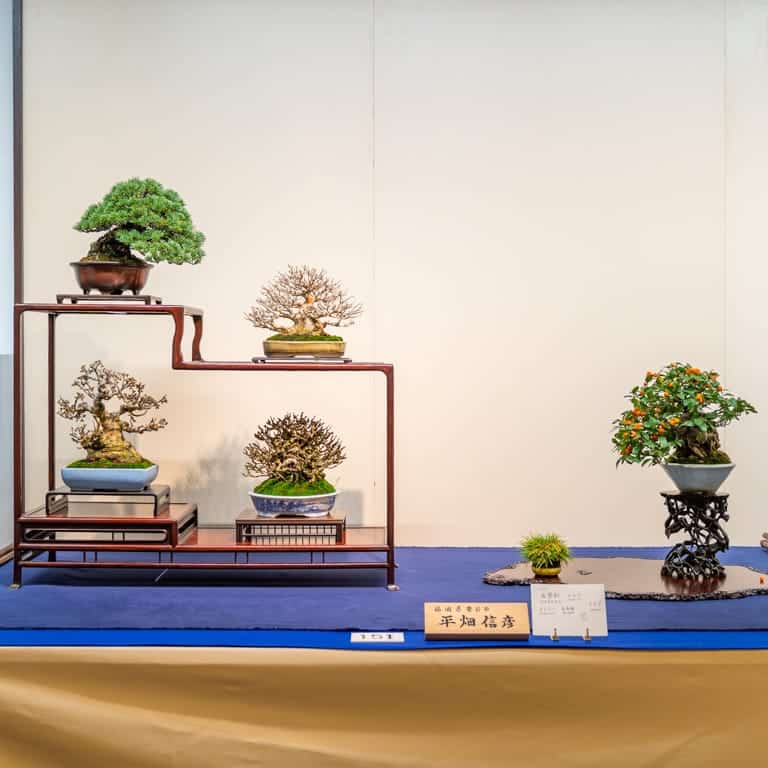A number of conventions guide the way bonsai are displayed at exhibits around the world. This post covers the basics.
The Space
Bonsai displays at Japanese exhibits are commonly six feet wide – about the length of one tatami mat.
As most bonsai are anywhere between a few inches tall and up to three or four feet at the tallest, a six foot space provides enough room to present one or more trees plus additional display elements as space allows.
Display Elements
Basic display elements include trees, stands, and accents.
To fill the display space, it’s common to display one large tree (18″ to 36″ tall), two medium trees (8″ to 18″ tall), or between one and ten small trees (up to 8″ tall). These conventions are designed to fill a six foot display space without overcrowding it.
Stands are used to raise trees above table height to improve the viewing experience.
Accents are non-bonsai display elements that can be used to create a story about the tree or trees on display.
Accents can be plants or flowers that suggest the season or the place where the tree grows in nature. Scrolls or figures such as bronze huts, fishermen, or animals can be used to suggest scale or set a scene.
Examples
The following examples are from the 2020 Kokufu exhibition. Although non-plant accents (such as figures) or scrolls are not used at Kokufu, it’s a good example of how to fill display space based on the size of the tree or trees on display.

One large tree and accent plant

Two medium trees and accent plant

Five shohin bonsai and accent plant

Ten mini bonsai and accent
While it would be fantastic to display small and medium trees on their own, exhibits would require lots of tall slender stands (or raised tables, or bending over a lot), and a lot of empty space (or very narrow display areas).
Additional Conventions
A few more conventions bear noting as they have a strong influence on how bonsai displays look.
- When displaying medium sized bonsai, one tree will be larger than the other.
- When creating a display for more than one tree, aim for contrast in the style of the tree, the foliage type, and the container.
- When displaying small bonsai (shohin), aim to use trees with roughly equivalent visual weight.
As far as the basic conventions go, that’s it!
Do bonsai need to be shown according to these conventions? Definitely not! There are lots of ways to show bonsai depending on the occasion and the goals of the exhibitor.
The above conventions address practical concerns about how to fill display space, whether in the home (in the case of tokonoma displays) or at an exhibit, but they’re not the only way to go about it.
The best way to learn display is to study displays you like and practice making displays with the elements you have on hand. Showing trees at club shows, or even at private events at home, can offer good opportunities for practice. Studying show books is a good way to see how display is practiced at Japanese, American, or European exhibits.
Not many classes offer opportunities to study general bonsai display, but quick online searches can turn up a handful of articles and videos on the topic.
- If you’re interested in getting hands-on experience with shohin display, check out the 2024 Shohin School Winter Seminar to be held in Portland, Oregon this coming January.
- You can also study shohin display in Gafu-ten books
- For examples of basic display conventions (and fantastic bonsai!), you can study Kokufu books
- For examples of American displays, check out photo books from the US National Bonsai Exhibition or the Pacific Bonsai Expo
